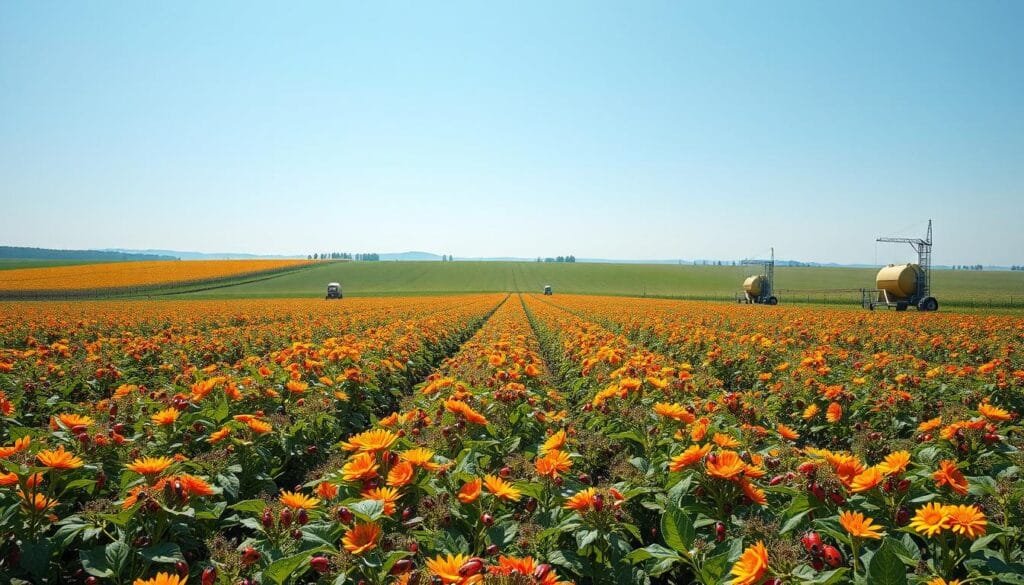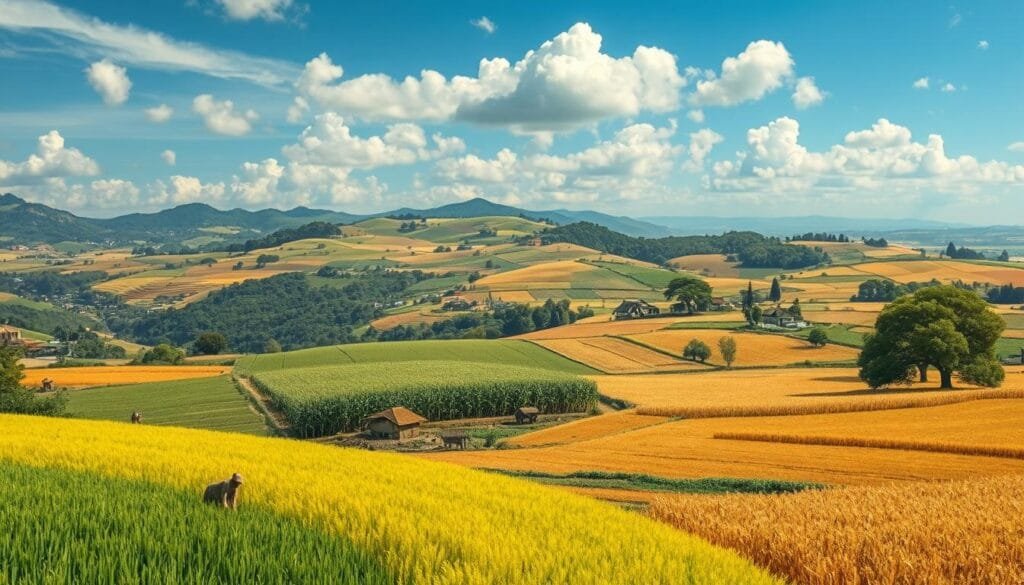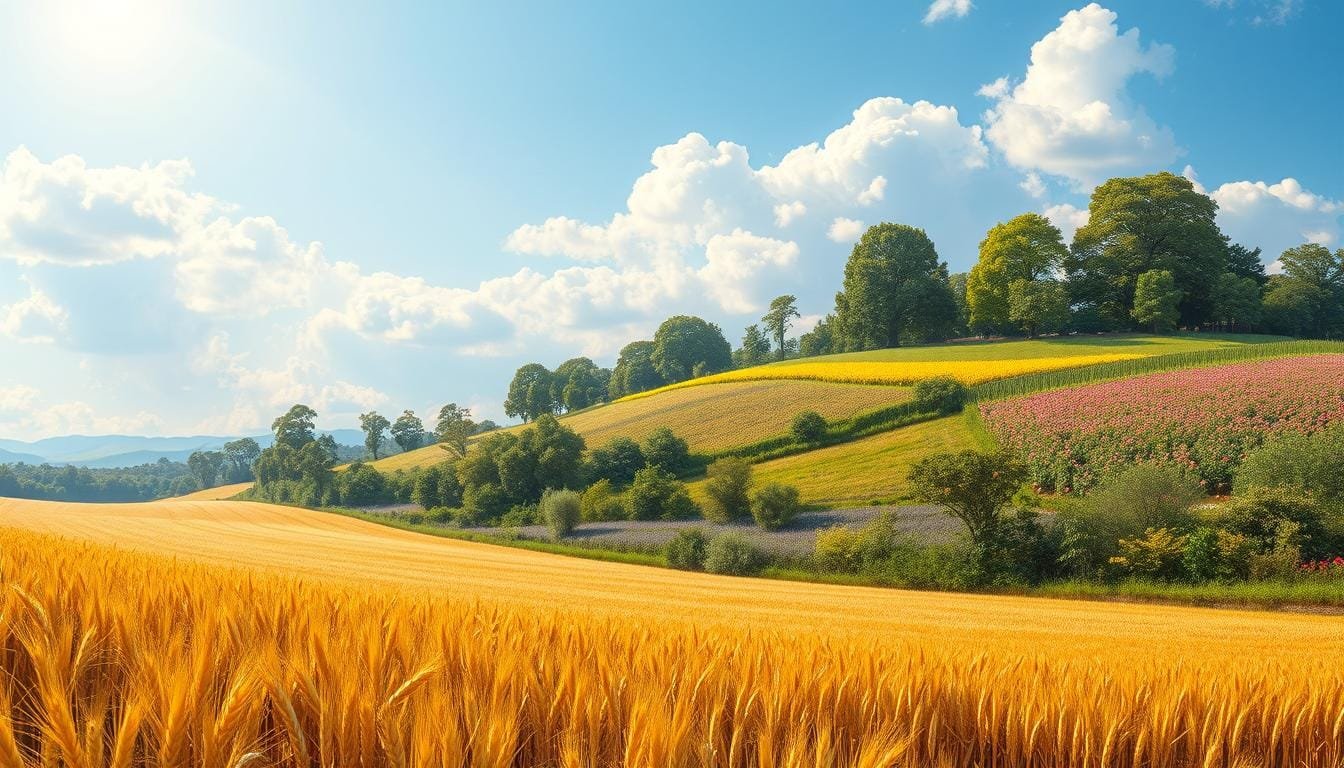Have you ever thought about how our farming methods affect our world and society? Monoculture farming is a key method in meeting our global food needs. This practice has shaped farming and cultural growth from ancient times to modern-day agriculture.
Monoculture involves growing just one crop or breeding one animal type in an area. It aims at increasing yields and making farm management easier. Yet, it raises concerns about our agricultural systems’ sustainability, impact on the environment, and future.
How do cultures worldwide handle monoculture farming? And is it really as common as it seems?
Despite what many think, a lot of modern farmers choose crop rotation over monocropping. In the USA, 82-96% of cropland uses crop rotation. In France, only 1% of farms don’t use rotation. History shows us that diversified farming has been appreciated since 6000 BC. This tells us monoculture farming may not be as widespread as believed. Want to dive deeper into how monoculture affects our farming methods and culture? Keep reading for more details.
Let’s start by exploring what monoculture farming is and its roots. See how it stacks up against polyculture. We’ll look at the pros and cons of monoculture. Also, we’ll check out how technology is changing monoculture farming. And we’ll learn how different cultures have farmed through history.
Read more here about global monoculture farming and its environmental impact.
Key Takeaways
- Monoculture farming involves growing a single crop or raising a single type of animal in a specific area.
- Global farming practices vary widely, with many regions favoring crop rotation over monoculture.
- Historical agricultural methods, including those documented as early as 6000 BC, support diversified farming techniques.
- Despite the efficiency of monoculture, it can lead to environmental issues such as soil degradation and biodiversity loss.
- Technological advances in agriculture aim to address some of the challenges posed by monoculture farming.
What Is Monoculture Farming?
Monoculture farming is about growing just one crop or raising one type of animal in an area. It’s efficient but has its problems and debates.
Definition and History
The practice of monoculture means only one kind of crop or livestock is farmed in one place. It aims to increase productivity and profits by making things simpler. Monoculture started to grow after 1945, moving away from traditional farming due to new techniques. The Green Revolution brought cheap nitrogen fertilizers, making monoculture more common. However, it can strip soil nutrients and requires lots of fertilizers. This leads to soil and water pollution issues.
Types of Monoculture Farming
Monoculture farming comes in different forms depending on the agriculture focus:
- Annual Monoculture: This means planting the same yearly crop over and over, like corn or wheat.
- Perennial Monoculture: It’s about crops that last many seasons without replanting, such as orchards or vineyards.
Monoculture farming needs lots of pesticides and herbicides to control pests and weeds. This increases pollution. Fertilizers, chemical or organic, help replace nutrients but are expensive. Plus, this type of farming uses 80% of the world’s farmland, showing its growth and dominance.
Monoculture in Crop Production vs. Animal Farming
Crop monoculture includes large fields of soybeans or cotton. It’s crucial for food and other industries. But, these large fields can cause soil erosion and nutrient loss. This often leads to using synthetic fertilizers.
Animal monoculture, however, is about raising one livestock type, like dairy cows or chickens. It takes up 75% of global farm land. It mostly depends on monoculture crops for feed. Thus, crop and animal monoculture are closely linked. Both face issues like loss of biodiversity and more greenhouse gases due to increased machine use.
| Aspect | Crop Monoculture | Animal Monoculture |
|---|---|---|
| Primary Focus | Single crop variety (e.g., corn, soy) | Single animal species (e.g., dairy cows, poultry) |
| Environmental Impact | Soil degradation, erosion, nitrogen depletion | High greenhouse gas emissions, reliance on feed monocultures |
| Economic Practice | Higher productivity, lower biodiversity | Efficient livestock management, increased mechanization |
| Land Use | 80% of global arable land | 75% of agricultural land |
Pros and Cons of Monoculture Farming
Monoculture farming involves growing the same crop every year on the same land. It has its ups and downs. Understanding these can help everyone better grasp this farming method and its impact.

Advantages
Monoculture boosts efficiency for farmers. By focusing on one crop, they cut down on labor and equipment costs. Special tools for a single crop can save labor costs by about 30% on big farms. This farming style helps produce more, which is crucial in places depending on one crop for their economy.
For instance, Texas is a top producer of cotton, with 2.8 million bales in 2023. Focusing on crops that yield a lot has been a key trend, boosting productivity and making crop care simpler.
Disadvantages
Despite its benefits, monoculture farming has downsides. One big problem is it makes crops more likely to get diseases and pests. Studies show that monoculture fields have about 33% more pest problems than fields with varied crops. This leads to more pesticide use, causing about 30% of pests to become resistant.
Soil health also suffers, with up to half of the soils used for farming losing nutrients over time. Monoculture needs twice the fertilizers than fields with different crops, adding costs and pollution. It can also harm local water sources and demands much more water, increasing environmental stress.
This farming method can cause waste, too. Up to 45% of some crops are not used every year.
Comparison to Polyculture Farming
When we look at monoculture versus polyculture farming, the differences are clear. Polyculture, which means growing many crops together, can produce 22% more. It helps soil health and reduces the need for chemicals. Growing different crops together can raise yields by 25% in dry times and 10% in normal times.
Biodiversity takes a hit with monoculture, dropping by up to 90% and hurting ecosystems. Polyculture, on the other hand, supports more plant and animal life. It makes for a stronger agricultural environment. The decline in bee health by 25% in monoculture areas risks crops that bees pollinate.
| Monoculture Farming | Polyculture Farming | |
|---|---|---|
| Pest Problems | 33% more pest-related issues | Fewer pest problems |
| Soil Health | 50% nutrient depletion | Improved soil fertility |
| Pesticide Usage | 30% pesticide resistance | Lower pesticide dependence |
| Water Demand | Up to 40% higher | Lower water usage |
| Biodiversity | 90% decline in local biodiversity | Support for diverse ecosystems |
Impact of Monoculture Farming on the Environment
Monoculture farming is common, but it comes with big downsides. This section explores the bad effects of monoculture. We look at soil harm, dealing with pests and diseases, and losing biodiversity.
Soil Degradation and Fertility Loss
Soil degradation is a major problem of monoculture. Relying too much on growing one crop hurts soil health. It causes more runoff and more plant diseases.
This approach also makes crops more open to pests and diseases. Overusing synthetic fertilizers pollutes the soil. Sadly, many areas focusing on one crop type face reduced soil fertility and quality.
Think about this: lots of water from irrigation is needed for these farms. It uses up our natural water supplies. Monoculture farming also needs more water, hurting aquatic life. This bad cycle leads to even more use of chemicals.
Pest and Disease Management
Managing pests in monocultures is full of problems. A good example is when 15% of North America’s corn was destroyed in 1970. It was because farms relied on one type of corn. This shows the risks of planting just one variety.
“The increased pesticide use resulting from monoculture farming is exacerbated by rising temperatures. Climate models predict that hotter conditions will significantly impact crops like corn and wheat in the U.S. as soon as 2030.”

Effects on Biodiversity
Biodiversity loss is a big issue too. Focusing on just one crop wipes out many plant and animal species. It messes up the whole ecosystem. The loss of important species for pollination, pest control, and soil health puts ecosystems at risk.
| Aspect | Impact |
|---|---|
| Soil Health | Increases runoff and decreases fertility |
| Pest Control | Higher vulnerability to pests and increased pesticide use |
| Biodiversity | Reduces species diversity and disrupts ecosystems |
We need to understand how monoculture farming hurts the environment. It’s crucial for creating better ways to farm. The damage to soil health, pest control issues, and biodiversity loss all call for a change in how we farm.
Technological Advances in Monoculture Farming
Monoculture farming has changed a lot thanks to agriculture technology. These new farming solutions are key for increasing crop amounts, using resources wisely, and lessening some of the damage to nature.
Today, more than half of the world’s farm land grows just a few crops like wheat and soy. Thanks to genetic modifications, these plants can handle tough weather better, leading to more food produced. Introducing crop rotation and growing high-yield crop types are big achievements in monoculture advancements. This is especially true in areas good for growing cereals such as oats and canola.
But, managing pests and diseases over large areas is tough. Precision farming tech helps apply just the right amount of chemicals. This cuts down on waste and helps keep our water clean. Yet, the use of certain pesticides has been linked to a drop in bee numbers around the world.
Using high-tech machinery has made farming more efficient. But it also leads to hard, eroded soil. Precision farming, with its satellite monitoring, gives up-to-date info on soil and crop health. It alerts farmers early to pest problems. But, if not used right, it can cause more pests to appear.
Monoculture has also brought in synthetic fertilizers and pesticides for more crops and lower costs. Yet, these chemicals can harm the soil and water. Even so, these practices often mean more food is made for less money, compared to old ways of farming.
The way monoculture farming affects our planet is still a big worry. It can lead to less different types of plants and animals and more climate change gases. But, modern farming innovations and new tech could help make growing crops this way better for the earth in the long run.
Did Every Culture Practice Monoculture Farming?
Throughout history, farming styles have varied greatly across the globe. This variation came from each region’s needs, environments, and cultures. By looking at cultural agricultural practices, we learn more about how different people farmed. This gives us a clearer image of farming’s rich diversity.
Historical Agricultural Practices
In the past, not everyone farmed the same way. Many ancient societies grew several types of crops together. This mixed farming approach was common in regions like ancient Mesoamerica and Southeast Asia. It boosted soil health and crop variety. Even though today’s farming often favors single crops, past methods embraced variety and sustainability.
Regional Variations
Farming methods changed a lot depending on the region. Europe, for instance, widely practiced crop rotation. This helped keep the soil rich and pest-free.
In Africa, farmers often mixed different crops on the same land, a method known as intercropping. These examples show how farming adapted to meet local needs. For example, the huge monoculture fields in the U.S. Midwest are a stark contrast to the diverse farms in Asia and Africa.

Modern Trends
Today, farming combines old ways with new technology. While single-crop farming is common for its cost efficiency, it has drawbacks. For instance, pests become more resistant and soil loses its nutrients faster in monocultures.
However, there’s a growing movement towards sustainable farming. This includes a revival of mixed-crop farms and organic farming methods. The goal is to reduce the negative effects of intensive farming. This trend aims for healthier soil and ecosystems for the future.
Conclusion
In our deep dive into monoculture farming, it’s clear that there are ups and downs. One the one hand, monoculture boosts productivity and makes managing farms easier. But on the other hand, it can hurt the environment by harming the soil and reducing the variety of life. This issue matters a lot today as we aim to farm in ways that don’t harm our planet.
Technological upgrades, like precision farming and GMOs, offer chances to farm more efficiently. Yet, they don’t always fix the harm to nature. Our research showed that while crops like cereal rye and canola do great alone, mixing different crops didn’t always help nature more. This tells us something important: we need to find a balance between farming a lot and keeping our ecosystems healthy.
Monoculture farming has a big impact on farming around the world. Although different places have their own ways of farming, many now choose monoculture for money reasons. Yet, facing issues like climate change and not having enough food, we must think about new ways to farm. Our studies suggest using methods like crop rotation and growing a mix of crops. This can help our soil and make sure we have food for the future. For both our planet and our meals, choosing sustainable farming is key.
FAQ
What is the definition of monoculture farming?
Monoculture farming means growing only one kind of crop or raising one type of animal in a certain place. It makes farming easier and more efficient.
What are the historical roots of monoculture farming?
Monoculture farming began with early farmers who simplified their work to be more efficient. It grew as people wanted to make more food regularly and in bigger amounts.
What are the types of monoculture farming?
There are two main types: growing crops and farming animals. Each one needs different methods and care for the one species they focus on.
What are the advantages of monoculture farming?
Monoculture farming makes it easier to plant and harvest. It also simplifies managing crops or livestock and allows farmers to specialize.
What are the disadvantages of monoculture farming?
It has several downsides like more pesticide use, higher risk of pests, soil damage, and nutrient loss. These issues can harm the environment and make farming harder in the future.
How does monoculture farming compare to polyculture farming?
Monoculture farming focuses on one species. Polyculture involves many species in the same area. Polyculture is better for nature but monoculture can be more efficient, though it might harm the environment more.
What is the impact of monoculture farming on soil health?
Growing the same crop over and over hurts soil health and fertility. It happens because the soil loses its nutrients faster than when different crops are grown.
How does monoculture farming affect pest and disease management?
It makes farmers use more chemicals since pests and diseases that like the crop can become big problems quickly.
What are the effects of monoculture farming on biodiversity?
Monoculture makes environments simpler and less varied. This can upset natural balances and hurt biodiversity.
What technological advances have been integrated into monoculture farming?
New tech includes genetic changes, advanced machines, precise farming, and satellite checks. These help improve yields, use resources wisely, and reduce some bad effects on nature.
Did every culture historically practice monoculture farming?
Not all cultures used monoculture. Different places had their own farming ways, based on their environment, culture, and economy. This shows how farming can adapt to different situations.
How have regional variations influenced monoculture farming?
Climate, soil, and cultural tastes have affected how monoculture farming is done. In some places, it’s the main way to farm because it suits the economy and growing conditions. But some areas still keep traditional, varied farming alive.
What are the modern trends in global agriculture?
Today’s trends include using new technology, moving towards sustainable methods, and mixing monoculture with polyculture. This is to fix environmental issues and make sure we have enough food.
